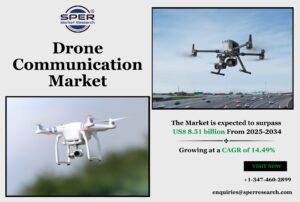Drone Communication Market Demand and Growth 2034

The network of connections and technologies that enable drones (unmanned aerial vehicles) to communicate with other drones, satellites, ground control stations, and other connected devices via exchanging signals, data, and commands is known as drone communication. It makes it possible to transmit vital data, such as sensor data, navigational information, telemetry, and live video streams, to guarantee operations are safe and effective. Depending on the goal and the environment, communication can be created by radio frequency (RF), satellite communication (SATCOM), mesh networking, cellular networks (4G/5G), or optical/infrared systems. It enables safe, encrypted connections for surveillance and combat operations in defense applications, and it supports delivery, inspection, and disaster management services in the commercial sector.
According to SPER market research, ‘Global Drone Communication Market Size- By Communication, By Application, By End User- Regional Outlook, Competitive Strategies and Segment Forecast to 2034’ states that the Global Drone Communication Market is predicted to reach 8.51 billion by 2034 with a CAGR of 14.49%.
Drivers:
The increasing use of drones in sectors like public safety, defense, agriculture, logistics, construction, and energy, which depend on dependable real-time connectivity for operations, the global drone communication market is expanding. The necessity for high-speed data transmission and the growing demand for beyond visual line of sight (BVLOS) missions is driving the adoption of cutting-edge communication technologies including mesh networks, 5G, and SATCOM. The need for secure and encrypted communication solutions is also being fueled by government ambitions to integrate UAVs into regulated airspace and defense modernization programs. Furthermore, investment in strong communication infrastructure is increasing due to the growth of commercial applications including drone delivery, inspection services, surveillance, and disaster management.
Download the Detailed Analysis in PDF format, Here
Restraints:
Governments enforce stringent regulations on frequency usage, beyond visual line of sight (BVLOS) flights, and airspace integration, which offer significant difficulties to the worldwide drone communication market. These problems are mostly connected to regulatory constraints and spectrum availability. Safe drone operations are seriously threatened by cybersecurity threats including hacking, jamming, and spoofing, which makes strong encryption and anti-jamming solutions even more important. The use of satellite communication systems, sophisticated radio frequency modules, and secure networking infrastructure is further restricted by their high costs, particularly for commercial sectors that are cost-sensitive. Reliability is further impacted by environmental factors such as signal interference, range limitations, and latency problems in urban or rural locations.
Regional Analysis:
In 2024, North America led the global drone communication sector. This region is home to significant global entities in the drone industry, including Skydio, 3D Robotics, PrecisionHawk, AeroVironment, among others, which has resulted in a substantial number of businesses related to drones. The rising demand for both hardware and software, encompassing drone services, has spurred the creation of many companies and startups, reflecting a vibrant market. Some of the key market players are DJI, Parrot SA, Lockheed Martin, Northrop Grumman, Raytheon Technologies, Thales Group, L3Harris Technologies, Boeing (Insitu), Textron Systems, AeroVironment, Elbit Systems, and others.
For More Information, refer to below link: –
Drone Communication Market Growth
Related Reports:
Europe Armored Fighting Vehicles Market Size
Aircraft Fire Protection System Market Size
Follow Us –
LinkedIn | Instagram | Facebook | Twitter
Contact Us:
Sara Lopes, Business Consultant — USA
SPER Market Research
enquiries@sperresearch.com
+1–347–460–2899





